A Rice Journey > Thailand
泰國 Thailand
text: 黃嬿庭 Yen-Ting Huang
photography: 陳凱倫 Karen Chen
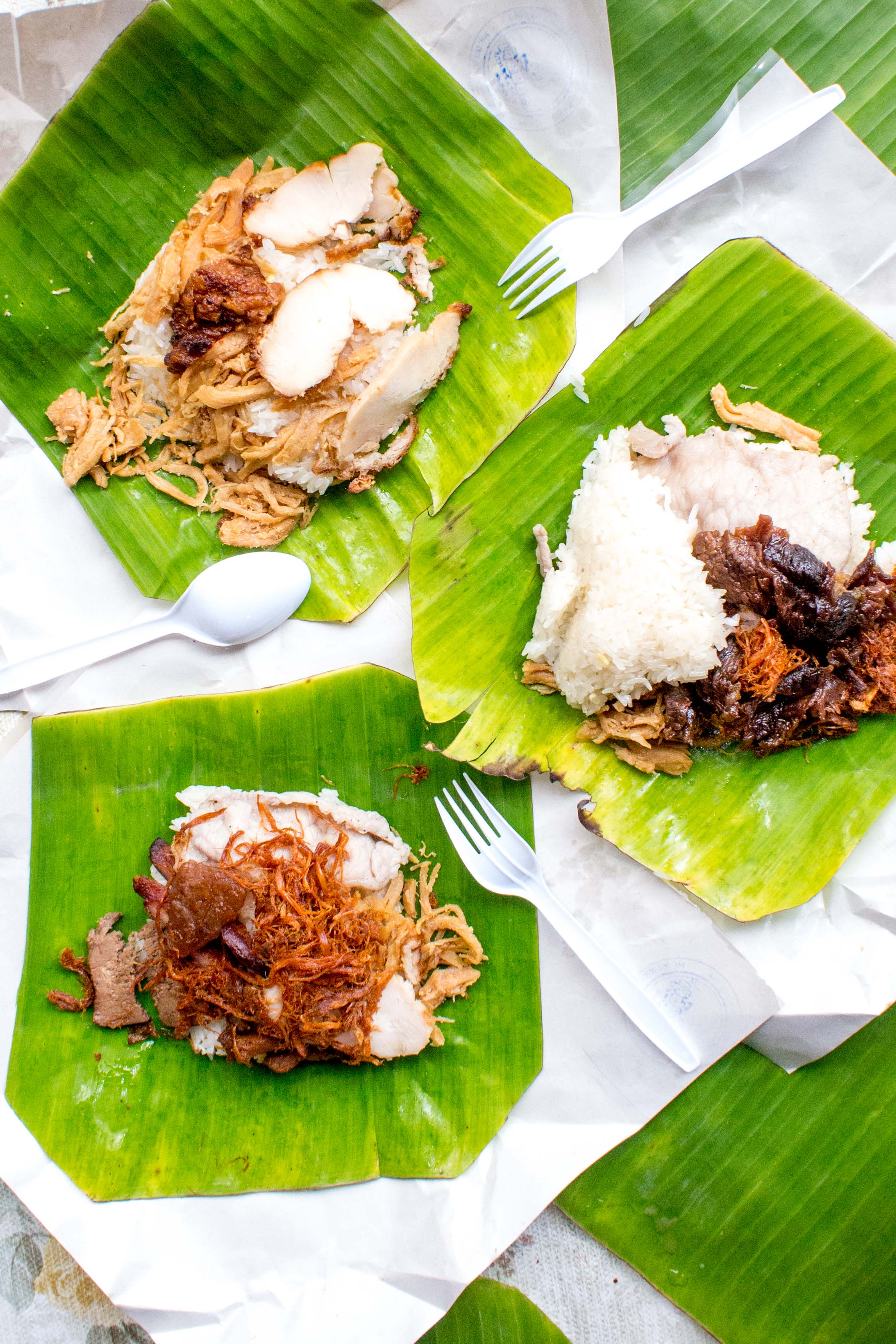

泰國飯糰實錄
A Record of Thai Rice Balls
走在清晨的曼谷街頭,偶爾會飄來幾股猖狂的油煙味,烤豬肉、烤雞、炸雞腿,乍看之下,似乎除了賣得有點早,和台灣的燒烤和鹹酥雞並無二致,但仔細一瞧,就會發現這些賣烤肉炸雞的小販,都少不了一個標配:用塑膠袋裝起的一球球糯米飯。กินข้าวหรือยัง,吃飯沒?一句看似和台語「呷飽未」相似的問候,其實透露了泰國人以米飯為主食的飲食習慣,而且大多數人從早餐開始就是無飯不歡派,不僅自己吃,也會準備白飯和配菜供奉化緣的僧人,有些上了年紀的泰國人,甚至會認為沒吃到白飯就稱不上是吃了一餐。
相較於曼谷人習慣吃白米飯,在泰國北部及東北部,傳統上以糯米飯為主食,在早期的農業社會中,農人會將糯米蒸熟後放進小竹簍裡,帶出門去當早午餐,熱量和營養價值都高的糯米,能快速補充體力,是務農者的午餐首選,對離鄉背井到曼谷打拚的勞工而言,也是家鄉的味道,但糯米飯來到曼谷後,也逐漸演變出新的食用方式,其中一種,便是蕉葉飯糰。
Walking in the streets of Bangkok on an early morning, pedestrians would catch a whiff of greasy delicacies such as grilled pork, grilled chicken, fried drumsticks, etc. It seems early for such a heavy meal that is akin to Taiwan’s barbeque or fried chicken, but upon closer inspection, you will find that the vendors all share a common denominator: small plastic bags containing glutinous rice balls.
Similar to a Taiwanese greeting, กินข้าวหรือยัง is Thai for “have you eaten rice yet?” The greeting reveals the main staple food for Thai people to be rice. Many Thai people will start eating rice from breakfast and also prepare rice and other dishes for monks. For older Thai generations, rice is a necessity, and a meal without rice is not a meal at all.
While the people of Bangkok eat white rice, the people of Northern Thailand and Northeast Thailand traditionally eat glutinous rice as their staple food. In early agrarian society, farmers will steam the glutinous rice and then place it into small bamboo baskets as breakfast or lunch out in the fields. Glutinous rice is high in calories and nutrition, making it a quick source of energy for farmers to have for lunch. For migrant workers that have left their homes to work in Bangkok, glutinous rice is the taste of home. Yet when glutinous rice gradually made its way to Bangkok, the people of Bangkok created new ways of eating it, one of which was banana leaf rice balls.
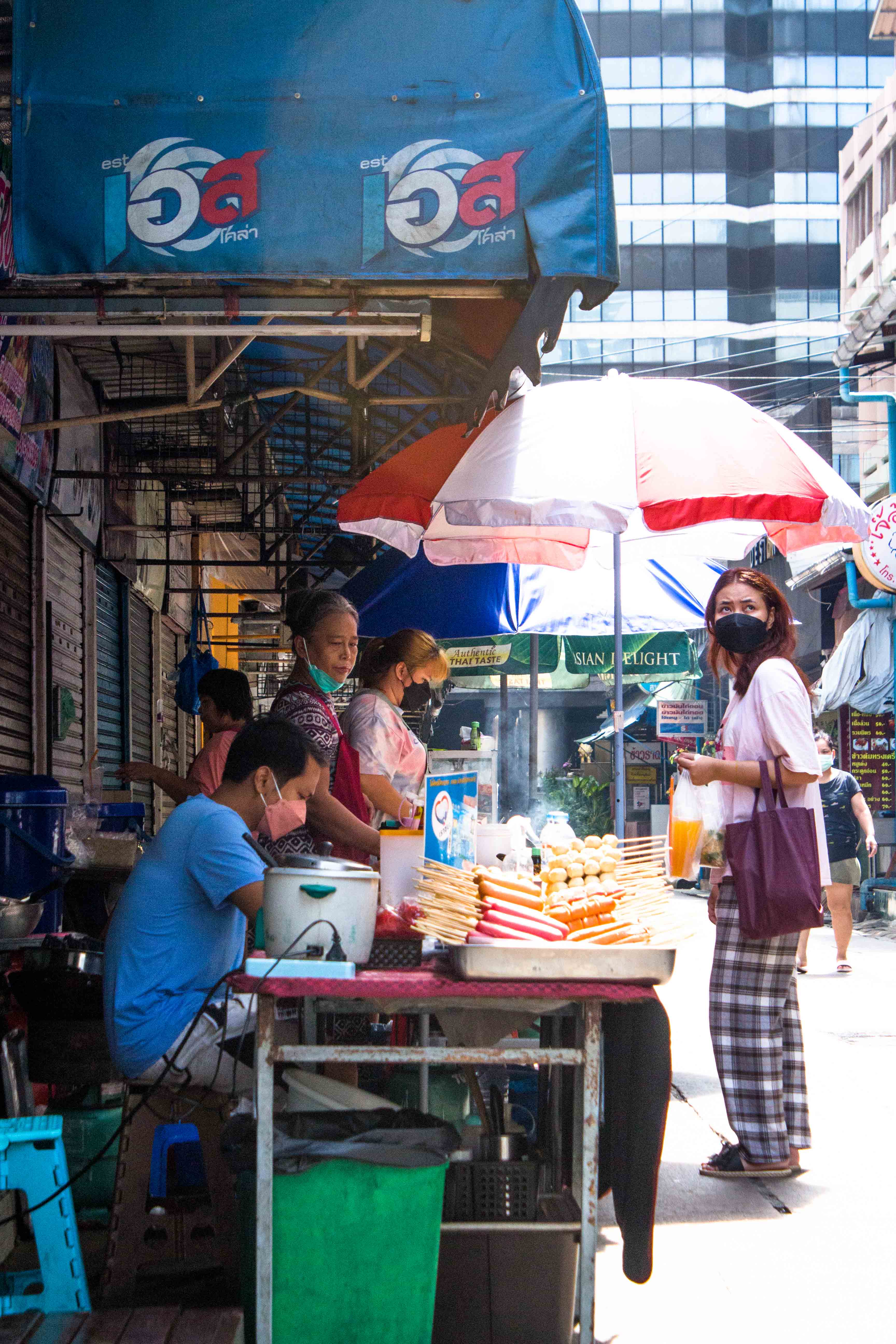


改良自家鄉味的鐵路便當
蕉葉飯糰 (ข้าวเหนียวห่อใบตอง)
Railway Bento from Home, Reinvented
Banana Leaf Rice Balls (ข้าวเหนียวห่อใบตอง)
搭乘曼谷空鐵BTS,在市中心商業區的阿里站下車,我們在兩棟高聳商業大樓間的小巷裡,找到了Ooi阿姨的飯糰店。
一台小餐車從屋簷下的小店舖延伸出來,檯面上擺著幾個大鐵碗,裡面盛滿了各式各樣的肉品,餐車側面擺著兩個大保溫桶,有客人上門,便打開保溫桶挖出糯米飯,鋪在香蕉葉上,再根據客人的需求放上配料,最後用防油紙壓緊包起來,折成四方體,一顆飯糰就完成了。
「我自己是賣二十幾年了,但這種飯糰已經有四、五十年的歷史,他們最早是沿著鐵路叫賣的。」1950年代,泰國進入美援時期,在工業發展和都市化之下,許多勞工從泰國北部及東北部的鄉村來到曼谷謀生,當時要來往農村、郊區和市中心,主要的交通方式舊式火車,因此在鐵路沿線和火車站附近,便出現了挑著扁擔,叫賣餐點的小販,其中一種因應而生的小吃,便是將糯米包裹在香蕉葉裡,和配料一起販售的蕉葉飯糰。
We took the Bangkok Mass Transit System (BTS) and got off at the Ari BTS Station, located in the heart of Bangkok’s commercial district. In an alley tucked between two sky-scraping office buildings, we found Auntie Ooi’s rice ball shop.
A small cart juts out of the tarped store. On the surface, we found several large steel bowls filled with various meats. There were two large insulated barrels on the side of the cart. Whenever customers came, Auntie Ooi would scoop out glutinous rice from the insulated barrels, spread it onto the banana leaf, and then add meats and vegetables based on customer preference. The rice ball is then wrapped in grease-resistant paper and folded into a square.
“I’ve been selling rice balls for over twenty years now but these rice balls have been around for forty to fifty years. They were first sold along the railways.” In the 1950s, Thai gained American support and started a period of industrial development and urbanization, which prompted workers to travel from villages in Northern and Northeast Thailand to Bangkok for work. The main transportation from to and from villages, rural areas, and city centers were old trains. As such, along the railway and inside train stations, vendors carrying shoulder poles filled with food emerged and gave rise to various snacks such as banana leaf rice balls.


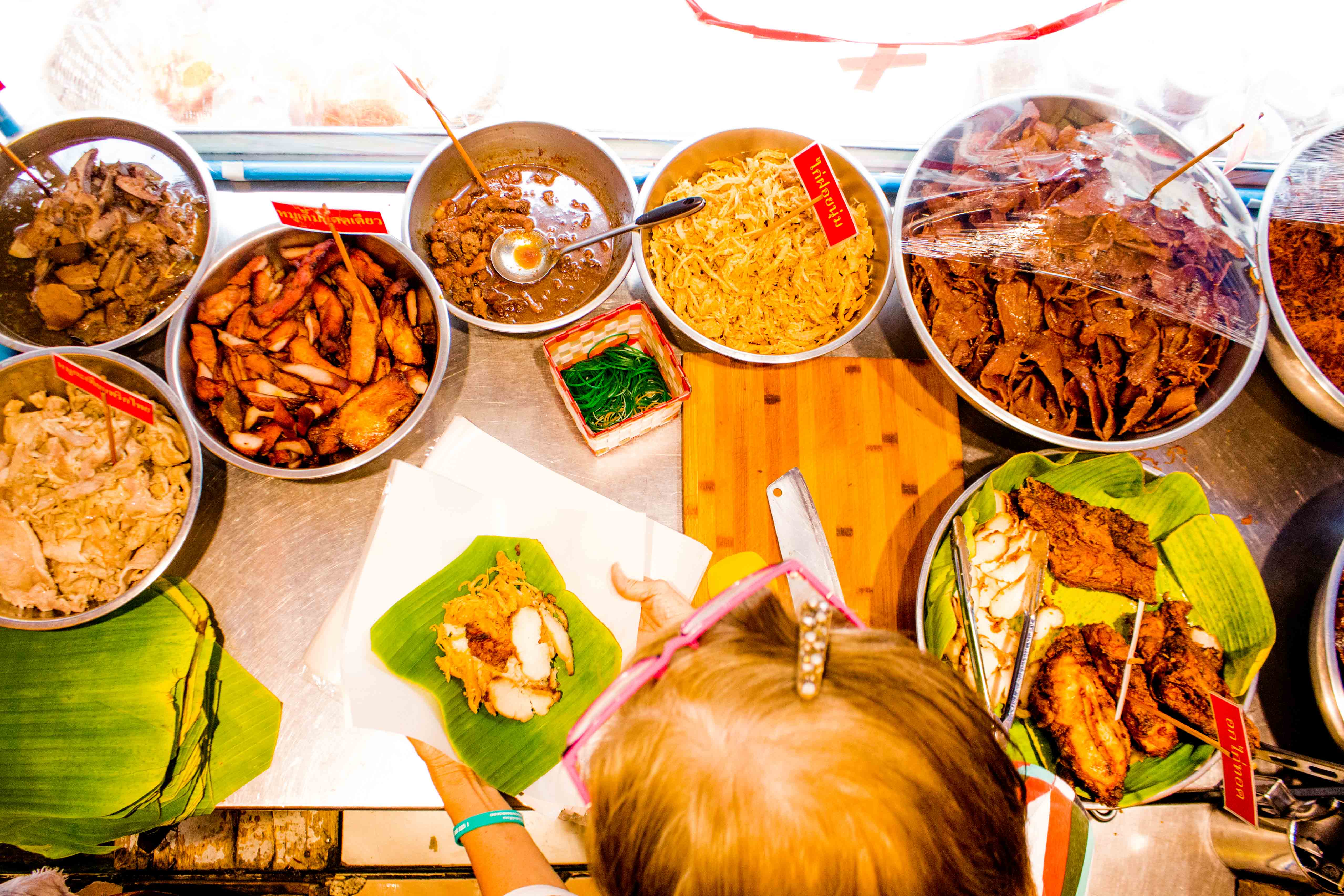
關於這段歷史,我們透過電話訪問了對美食頗有研究的泰國作家Tone,「會出現這種飯糰,除了是因為外來人口到曼谷討生活,在時間和居住環境上有所限制,無法自己蒸糯米之外,還有一點是自卑感,由於糯米是泰國北部和東北地區的主食,過去食用糯米會被認為是鄉下人,他們不敢跟在家鄉時一樣,大喇喇地拿著裝糯米的竹簍去上班,這種新的食用方式便是他們的好選擇。」
除此之外,和傳統的糯米食用習慣相比,蕉葉飯糰在配料上,也順應曼谷人的口味跟著「曼谷化」了。在北部和東北部,糯米是搭配當地特色的臭魚醬、烤雞或涼湯食用,但來到了人口組成以華人為主的曼谷後,蕉葉飯糰轉而以豬肉為主要配料,並以油炸為主要的配料烹調方式,後來更加入了肉鬆、肉乾等華人傳統食材。可說蕉葉飯糰的背後,乘載著在泰國經濟發展下,一群異鄉人到大城市打拚,最終融入當地的故事。
We interviewed Tone, a Thai author and food connoisseur, over the telephone about this era. “These rice balls came about because migrant workers in Bangkok had limited time and restrictive living conditions that prevented them from steaming their own glutinous rice. It was also a matter of stigma as glutinous rice is the staple food for Northern and Northeast Thailand and so anyone eating glutinous rice would immediately be labeled as a countryman. They were afraid to carry glutinous rice in bamboo baskets to work as they would at home and so the banana leaf rice balls became their solution.”
Banana leaf rice balls, as opposed to traditional dietary habits of glutinous rice, opts for Bangkok flavors, meats, and vegetables. In Northern and Northeast Thailand, glutinous rice is paired with roasted chicken, cold soups, or fish sauce (a local specialty). With a predominantly Chinese population in Bangkok, pork became one of the main ingredients in banana leaf rice balls, and frying became the main culinary approach. Other traditional Chinese ingredients such as pork floss and jerkies were also slowly introduced into banana leaf rice balls. One can say that the history of banana leaf rice balls is a story of migrant workers trying to make it in the big city and their successful integration against the backdrop of Thailand’s economic growth.
除此之外,和傳統的糯米食用習慣相比,蕉葉飯糰在配料上,也順應曼谷人的口味跟著「曼谷化」了。在北部和東北部,糯米是搭配當地特色的臭魚醬、烤雞或涼湯食用,但來到了人口組成以華人為主的曼谷後,蕉葉飯糰轉而以豬肉為主要配料,並以油炸為主要的配料烹調方式,後來更加入了肉鬆、肉乾等華人傳統食材。可說蕉葉飯糰的背後,乘載著在泰國經濟發展下,一群異鄉人到大城市打拚,最終融入當地的故事。
We interviewed Tone, a Thai author and food connoisseur, over the telephone about this era. “These rice balls came about because migrant workers in Bangkok had limited time and restrictive living conditions that prevented them from steaming their own glutinous rice. It was also a matter of stigma as glutinous rice is the staple food for Northern and Northeast Thailand and so anyone eating glutinous rice would immediately be labeled as a countryman. They were afraid to carry glutinous rice in bamboo baskets to work as they would at home and so the banana leaf rice balls became their solution.”
Banana leaf rice balls, as opposed to traditional dietary habits of glutinous rice, opts for Bangkok flavors, meats, and vegetables. In Northern and Northeast Thailand, glutinous rice is paired with roasted chicken, cold soups, or fish sauce (a local specialty). With a predominantly Chinese population in Bangkok, pork became one of the main ingredients in banana leaf rice balls, and frying became the main culinary approach. Other traditional Chinese ingredients such as pork floss and jerkies were also slowly introduced into banana leaf rice balls. One can say that the history of banana leaf rice balls is a story of migrant workers trying to make it in the big city and their successful integration against the backdrop of Thailand’s economic growth.


完美飯糰從糯米開始
The Perfect Rice Ball Starts with Glutinous Rice
作為飯糰的主角,糯米絕對不能馬虎,來買蕉葉飯糰的熟客們都不約而同地說,Ooi阿姨家的糯米特別好吃,而Ooi阿姨則透露,「生意好的時候,一天可以用掉兩大麻袋的糯米,將近一百公斤。」
如果用煮白米的方式,把糯米泡在水中煮,會讓煮出來的糯米變得糊爛,要煮出粒粒分明、能用手一塊塊抓起實用的糯米,必須將浸濕的糯米放在竹簍中,再放在滾著水的鍋子上,靠水蒸氣蒸熟。阿姨還另外分享了將糯米煮出香嫩口感的秘訣,就是在蒸糯米時加入去皮後的綠豆仁。
Ooi阿姨的店裡有黑白兩種糯米可以選擇。當今泰國市面上流通的白糯米多為RD6,這是1977年,將聞名全世界的泰國冠軍米「茉莉香米」加以改良後,培育出的長糯米。而黑糯米則和台灣常見的紫米相似,泰國黑糯米的原產地在泰北,當地農民相信,在田裡種植黑糯米,可以保護其他糯米免於蟲害。在蒸黑糯米時,通常不會整簍都放黑糯米,而是混著白糯米一起煮,煮好的飯會因此呈紫色。
As the star of the rice ball, the glutinous rice must be tended to with careful detail. Many of Auntie Ooi’s usuals agreed that her glutinous rice is especially yummy. Auntie Ooi revealed that “On a good day, we use up around two sacks of glutinous rice, which is about one hundred kg.”
If you cook glutinous the same way you cook white rice, immersing it in water, the glutinous rice will come out mushy. To make glutinous rice that doesn’t mush together but can be picked up by hand, you have to soak the glutinous rice, place it into a bamboo basket, and then put it in a pot with boiling water to let it steam through. Auntie Ooi also shared her secrets to making glutinous rice sweet and tender, adding peeled mung beans when steaming the rice.
At Auntie Ooi’s, customers can choose from black and white glutinous rice. The most common white glutinous rice in Thailand is RD6, long-grain glutinous rice adapted from Thai’s award-winning jasmine rice in 1977. The black glutinous rice is similar to Taiwan’s black rice. It is largely farmed in Northern Thailand as local farmers believe that black glutinous rice can prevent pests from harming other glutinous rice crops. Black glutinous rice is largely steamed with some white glutinous rice and looks purple after steaming.

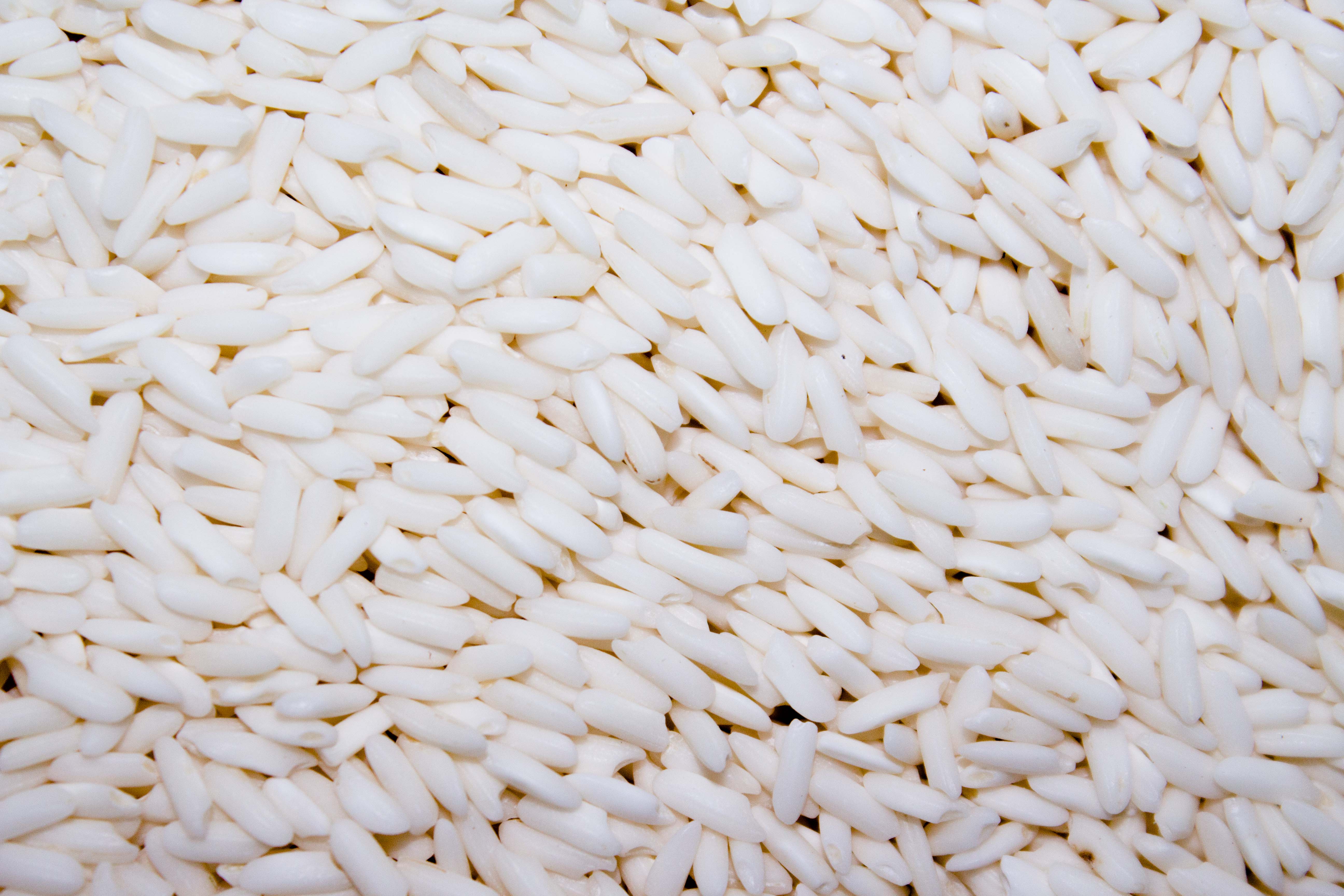

用心為熟客開發的好料
The Best for Customers
如前所述,大多數的蕉葉飯糰,在曼谷華人文化的影響下,搭配的是以豬肉為主的肉鬆、肉乾或炸物,而考慮到準備的方便性及保存難易度,很少會使用會出水的蔬菜和素料。
同樣是全葷的配料,但與其他店家相比,Ooi阿姨的配料顯得十分多元,不僅豬雞牛魚統統有,要炸、要烤,甚至是要醃漬物,也都樣樣具備。除非是加比較貴的料,不然每顆飯糰是30泰銖起價,每多加一種料多10銖,最多可以塞到九種料。
「一開始只有賣炸五花肉和烤雞,會有今天這麼多料,都是根據客人的要求調整的。像平常吃這種飯糰,不會有人配魚吃,但因為客人跟我說他好想吃炸魚,我的菜單就多了炸沙立魚(東南亞的一種小型鱸魚),後來也做了辣椒酥炒魚鬆。」
Ooi阿姨的配料中最獨特,也最受客人們歡迎的有三種:蒜香甜豬肉、豬肝,以及醬醃牛肉乾,蒜香甜豬肉是低溫炸過的蜜汁豬肉片,而豬肝除了是其他飯糰店看不到的用料外,更是滷得多汁入味、切得又厚實。
As mentioned before, most banana leaf rice balls are paired with pork ingredients such as pork floss, jerkies, or fried foods because of influences from Chinese cultures in Bangkok. For convenience and preservation, banana leaf rice balls rarely use vegetables or vegetable-based ingredients that produce water.
Though all banana leaf rice ball vendors use meat ingredients, Auntie Ooi’s ingredients are incredibly more diverse, with a range of pork, chicken, beef, and fish that is either fried, roasted, or pickled. With the exception of more expensive ingredients, each rice ball starts at 30 Thai baht and can hold up to nine additional ingredients that cost 10 Thai baht each.
“We started with fried pork belly and roasted chicken. Our customers made suggestions and we adapted accordingly, which is why we have so many different ingredients now. These rice balls that we usually eat, nobody will ever eat it with fish but someone told me that he really wanted a fried fish rice ball and so I added fried sea bass (a small sea bass variant from Southeast Asia) and later added spicy fish floss later on.”
The most unique and popular ingredients at Auntie Ooi’s are sweet garlic pork, pork liver, and beef jerky. The sweet garlic pork is sweet pork slices that are gently fried while the pork liver, practically unseen in other rice ball shops, is braised to juicy, flavorful perfection and then cut into thick slices.

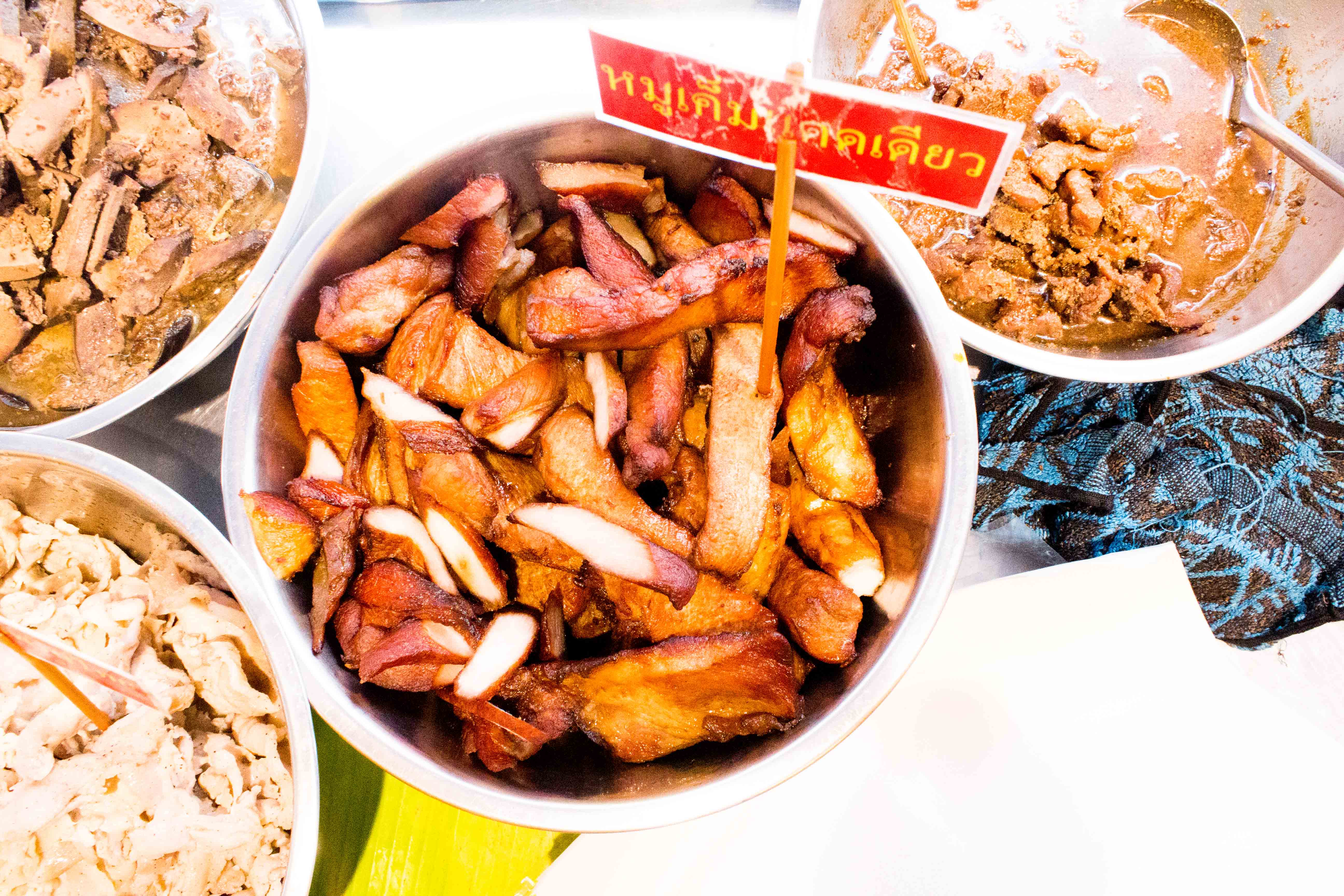
其中最難準備,價格也最高的,莫過於醬醃牛肉乾了,黑得發亮的醬醃牛肉乾,表面裹著薄薄的油脂,讓許多客人吮指回味,喜歡到會直接買一整包牛肉乾回家,一公斤的牛肉乾可以賣到1,400泰銖。牛肉乾好吃的秘訣,除了醬料本身,對溫度的掌控也很重要,「室溫超過30度的話,大概半天就能醃好,但如果遇上陰涼的雨天,可能就得醃個一天半才會入味。」
除此之外,阿姨店裡的雞絲也吸引了我們的注意,撕成條狀的雞肉用甜味醬汁調味,放在糯米上後,感覺與台灣雞肉飯上的雞絲有異曲同工之妙。Ooi阿姨說,一開始之所以會做雞絲,只是有段時間遇豬肉價格飛漲,便使用雞絲來取代豬肉絲,結果大受好評,成了新的配料。
The hardest to make and, therefore, the most expensive ingredient is beef jerky. So dark that it glows, the beef jerky is covered in a thin layer of fat that is simply finger-licking good. Customers sometimes buy a whole pack of beef jerky, which costs around 1,400 Thai baht for 1kg. The secrets to delectable beef jerky are not just the sauce but also the temperature. “At room temperatures over 30°C, the beef jerky only has to be marinated for half a day but on rainy, cold days, it will take a day and a half.”
Auntie Ooi’s shredded chicken also caught our attention. The shredded chicken is mixed with a sweet sauce and, when poured over glutinous rice, tastes rather similar to Taiwanese chicken rice. Auntie Ooi shared that she started making shredded chicken because of skyrocketing pork prices, but the shredded became an instant hit and remained a staple on the menu.
除此之外,阿姨店裡的雞絲也吸引了我們的注意,撕成條狀的雞肉用甜味醬汁調味,放在糯米上後,感覺與台灣雞肉飯上的雞絲有異曲同工之妙。Ooi阿姨說,一開始之所以會做雞絲,只是有段時間遇豬肉價格飛漲,便使用雞絲來取代豬肉絲,結果大受好評,成了新的配料。
The hardest to make and, therefore, the most expensive ingredient is beef jerky. So dark that it glows, the beef jerky is covered in a thin layer of fat that is simply finger-licking good. Customers sometimes buy a whole pack of beef jerky, which costs around 1,400 Thai baht for 1kg. The secrets to delectable beef jerky are not just the sauce but also the temperature. “At room temperatures over 30°C, the beef jerky only has to be marinated for half a day but on rainy, cold days, it will take a day and a half.”
Auntie Ooi’s shredded chicken also caught our attention. The shredded chicken is mixed with a sweet sauce and, when poured over glutinous rice, tastes rather similar to Taiwanese chicken rice. Auntie Ooi shared that she started making shredded chicken because of skyrocketing pork prices, but the shredded became an instant hit and remained a staple on the menu.


消費習慣與包裝
Consumer Habits & Packaging
生意最好的時段,還是平日的上下班時間,顧客多為附近商業大樓的上班族,但我們在週日上午到訪,一個小時內仍有不下十組客人,大多都是熟客,有些人是徒步或騎腳踏車來買的附近住戶,也有人是把車停在巷口,走進巷子裡來買飯糰。而正值疫情期間,更時不時可見到Lineman和Foodpanda外送員來向阿姨取餐的身影。
現今在泰國街邊販售的糯米,大多都是以防油紙或塑膠袋包裝,有些甚至會直接擺放在餐盒中,做成便當的形式,但大多都是飯與料分開放。台灣人所習慣的,將所有配料包裹在同一包裝裡的「飯糰」,在泰國並不是太普遍。
但在還沒有現代化包材前,香蕉葉是容易取得,且最被廣泛使用的包材。最初的飯糰並沒有將把料包在裏頭,是用一至兩片的香蕉葉包裹好糯米後,把配料擺在包好的蕉葉飯糰上方,再以用香蕉葉梗乾燥後製成的蕉葉繩綑綁固定。
我們注意到這款飯糰的外型與包裝方式,其實很難直接食用,而經訪問後,消費者們多半也沒有直接將飯糰拿起來啃的習慣,紛紛表示自己「都是打開來後用餐具吃。」
Peak hours are still when people are going to and getting off work on workdays. Her customers are largely office workers in nearby office buildings, but when we visited on a Sunday morning, there were still dozens of customers within a single hour. The Sunday crowd is mainly usuals that are either local residents walking or biking to Auntie Ooi’s or people that drive up to the alley and then make their way on foot to Auntie Ooi’s. With the pandemic still persisting, we also saw delivery people from Lineman and foodpanda come and go.
Most glutinous rice sold by street vendors in Thailand is wrapped in grease-resistant papers or plastic bags. Some will even put it into a bento box and sell it as a lunchbox, but the rice and sides are always placed separately. The Taiwanese rice balls with all the ingredients within the rice is actually uncommon in Thailand.
Before modernized packaging, banana leaves were easy to find and were a common packaging material. Original rice balls would never contain other ingredients. Vendors would wrap the glutinous rice in one or two banana leaves, place the additional ingredients on top of the wrapped rice pall, and tie the two together with banana leaf twine made from dried banana leaves.
We noticed that the way it looks and how it’s packaged makes it incredibly difficult to eat from. During our interviews, consumers explained that they don’t usually eat rice balls on the go but would actually “open it up and then eat it with utensils.”


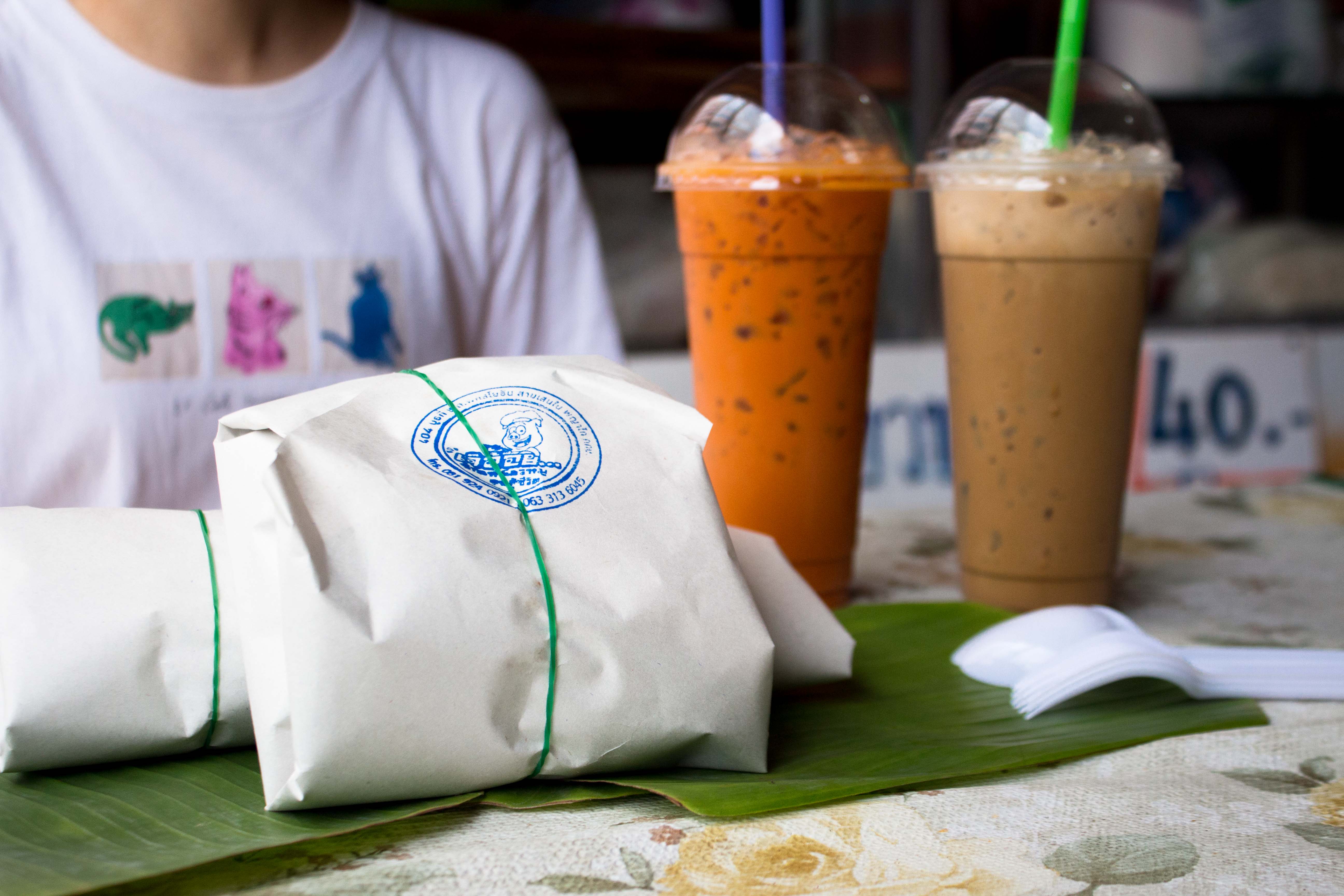
採訪後記
Epilogue
阿姨的店面招牌上寫著คนสู้ชีวิต,意思是「與生命奮鬥的人」。
1997年,亞洲金融危機重創泰國經濟,許多公司倒閉、大量人口失業,失去工作的人們只能到街頭賣冬陰功(泰式酸辣湯)等小吃,因此,亞洲金融危機在泰國被稱為「冬陰功危機」。原本是公司職員的Ooi阿姨也在這波危機中失去了工作,為了養大三個孩子,她嘗試賣了沙拉、煎蕊(一種椰奶和香蘭果凍製成的甜品),以及自助餐,但始終入不敷出。
而今,她在賣飯糰的攤子對面還有個店鋪,不只賣飯糰,也賣泰式炒河粉和自助餐,在許多熟客支持下也成了小有名氣的店。開始賣飯糰是成功的關鍵嗎?Ooi阿姨說,「其實賣飯糰之後,生計還是大起大落,有接過一天三千個飯糰的訂單,也曾過過負債百萬的日子,讓我走到今天的,不是飯糰,而是努力不懈的心。」
在經歷了許多有形及無形失去的疫情期間,阿姨的這番話,讓我們感受到了飽滿的生命力,一如蕉葉飯糰背後所乘載異鄉奮鬥精神,讓人不放棄對生命的希望。
The shop sign is คนสู้ชีวิต, which means “one fighting against life.”
In 1997, the Asian Financial Crisis hit Thailand’s economy hard. Many companies closed, and a large population was laid off. After losing their jobs, people went to the streets and started selling Tom Yum Soup (a sweet and sour Thai soup) and other street foods, leading to Thailand calling the Asian Financial Crisis the Tom Yum Soup Crisis. Auntie Ooi, previously an office worker, also lost her job during the crisis. To raise her three young children, she’s opened a salad shop, cendol shop (a dessert that contains green rice flour jelly and coconut milk), and even a self-serve restaurant, but could never make ends meet.
Now she has an actual shop across from her rice ball cart that sells not just rice balls but also Pad Thai and other dishes. With support from her usuals, her shop is now one of considerable reputation. Was selling rice balls the key to her success? Auntie Ooi explained that “I wasn’t making a stable income when I first started selling rice balls. I’ve had massive orders of 3,000 rice balls in a day and I’ve also been millions in debt. It wasn’t rice balls that gave me the life that I have now, it’s my perseverance and resilience.”
After enduring the pandemic and countless losses, we were inspired by her spirit and hopefulness of never giving up on life, similar to the resilience of migrant workers that banana leaf rice balls now represent.

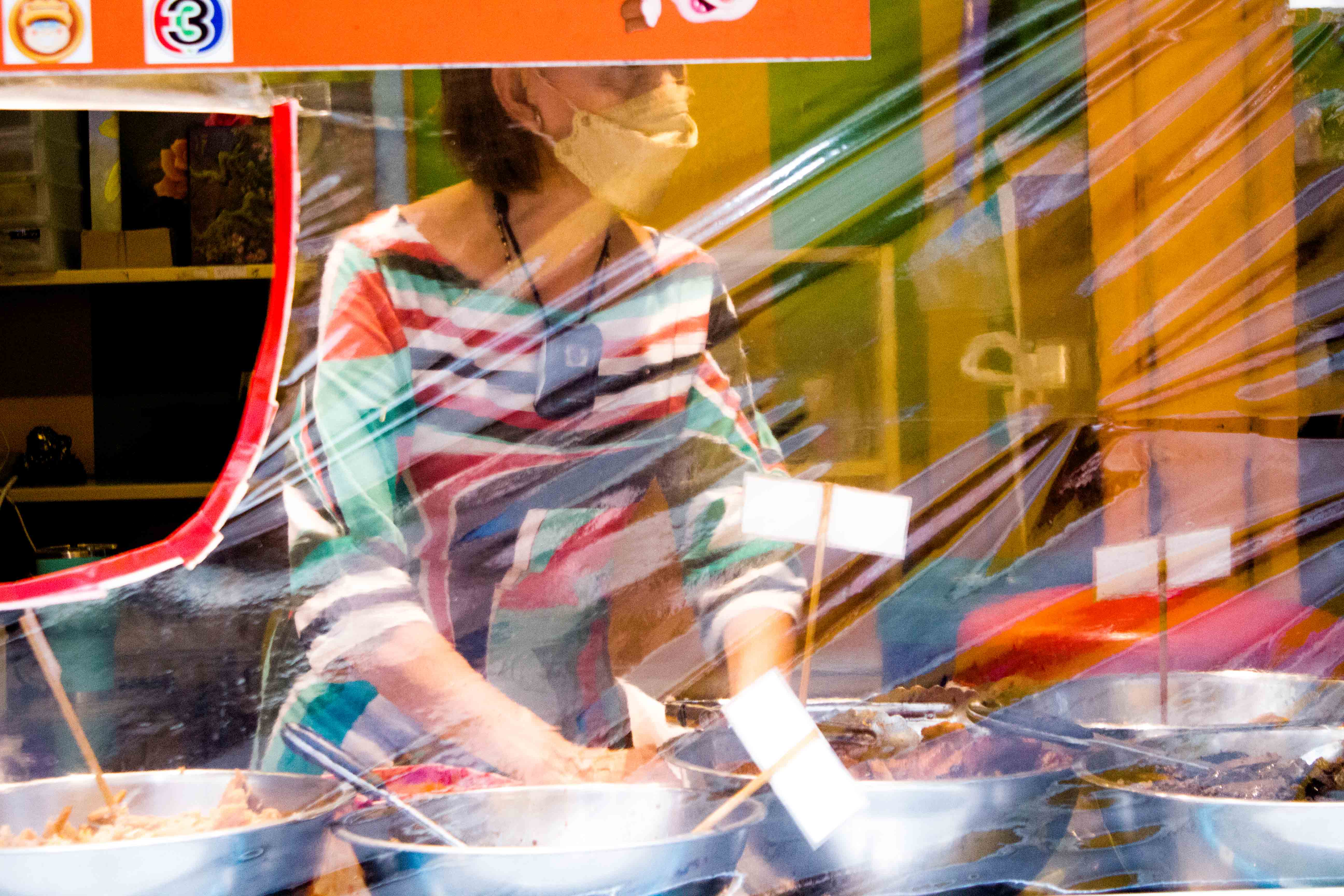


泰式粽子
蒸煮甜飯糰(ข้าวต้มมัด)
除了能作為正餐的飯糰之外,泰國也充滿以米食製成的甜食,例如世界聞名的芒果糯米飯,或是以糯米製成的各式糕點,其中,自然也有包裹成飯包形狀的甜飯糰,是將糯米炒過椰奶後,跟香蕉餡一起包入香蕉葉裡蒸,因此叫做蒸煮甜飯糰。
在曼谷近郊的佛統,我們訪問到一位在寺廟附近,擺攤賣蒸煮甜飯糰的老闆娘,有十多年經驗的她與我們分享製作甜飯糰的訣竅。她說,許多泰國人相信用明礬洗糯米,能讓糯米粒粒分明,但其實,用明礬洗過的糯米必須蒸煮更久,不但會讓糯米的養分流失,還得在蒸飯上花費更多成本。
老闆娘說,要將甜飯糰裡的椰奶糯米飯做得美味,必須把糯米、椰奶和砂糖的比例掌握在1: 0.6: 0.5,再適量加入一小袋鹽。據說要做出真正好吃的椰奶糯米飯,必須使用一種叫蛇牙米的糯米,這種形狀較短圓的糯米,原產於泰北清萊一帶,但隨著RD6的普及,純種的蛇牙米已經越來越少,價格也高,現在也大多使用RD6了。
蒸煮甜飯糰多以香蕉為餡料,有時會使用黑豆。雖說是香蕉餡,但使用的其實的是芭蕉,以泰國當地的Namwa蕉為主要食材,但老闆娘表示,品種並不重要,重點是要選用半熟狀態的芭蕉,蒸過的口感才是最好的。
做好的蒸煮甜飯糰,通常是兩到三顆綁成一綑,外型就像一綑綑的鹼粽,20泰銖可以買到兩三綑,是相當平價的庶民甜點。不論是在捷運站旁、住宅區巷口,或是水上市場,都可以看到蒸煮甜飯糰的蹤跡,它有時是甜點攤上的一隅,有時則是放在扁擔上販售,味道香濃甜膩,多半是需要工作一整天的人們,在下午時刻配茶的點心。
Thai Dumplings
Steamed Sweet Rice Balls (ข้าวต้มมัด)
In Thailand, rice can be made into rice balls and eaten as formal meals, but rice can also be made into sweets or desserts such as the world-famous mango sticky rice. Thai people also make various pastries out of rice, such as sweet rice balls where the glutinous rice is stir-fried in coconut milk, packaged in the banana leaf with banana filling, and then steamed, hence its name, the steamed sweet rice ball.
We found a lady selling steamed sweet rice balls near a temple in Nakhon Pathom, a city on the outskirts of Bangkok. She has over a decade of experience, and she shared her secrets to making steamed sweet rice balls, stating that many Thai people believe that washing glutinous rice with alum water will ensure that the glutinous rice doesn’t clump together but, in reality, the resulting glutinous rice takes longer to steam, loses nutrition, and produces a higher cost for steaming rice.
She shared that the secret to making delicious rice for sticky coconut rice is a glutinous rice, coconut milk, and white sugar ratio of 1:0.6:0.5 and then a small packet of salt. If you want to make really good coconut milk sticky rice, you have to use a shorter and rounder glutinous rice called Snake Tooth Rice, which originates from Chiang Rai of Northern Thailand. With the prevalence of RD6, pure Snake Tooth Rice is becoming harder to find and increasingly expensive, leading many to use RD6.
The most common filling for steamed sweet rice balls is banana fillings and, occasionally, black beans. Though we refer to it as banana filling, the filling is actually made from local lady finger bananas called Namwa, even though she went on to clarify that the type of banana is not really important. The key is to opt for semi-ripe bananas for the best texture after steaming.
Rice balls, when steamed, are usually tied together in groups of two or three and look like a bundle of alkali rice dumplings. An inexpensive dessert for the people, steamed sweet rice balls cost just 20 Thai bahts for two to three bundles. This popular dessert can be found next to BTS stations, alleyways, and floating markets. Sometimes it sits alongside other sweets and desserts at a stall. Sometimes it’s the star of the show on a shoulder pole. But it always tastes rich, sweet, and insanely good and is the perfect addition to afternoon teas for people that work around the clock.